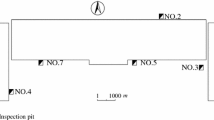Abstract
The instability of palygorskite and sepiolite under soil conditions was investigated to determine if these fibrous minerals transform directly to smectite under laboratory conditions. The treatment of 100 mg (0.12 mmole) of palygorskite with 1 mmole of NaOH solution (17 ml) at 150°C for 24 hr yielded a smectite. Analcime and smectite were formed when ≥ 3 mmole of NaOH was used. The addition of ≤ 6 mmole NaOH to sepiolite destroyed it gradually. On addition of ≥ 8 mmole NaOH, sepiolite altered to an X-ray amorphous material. In the presence of Al and Si, however, it transformed to smectite and analcime. Transmission electron microscopy, cation-exchange capacity, and X-ray powder diffraction studies of the products suggest that alteration wa. (1) via solution, o. (2) by a structural reorganization wherein the basic 2:1 silicate structural units were unchanged.
Резюме
Исследовалась нестабильность палыгорскита и сепиолита в почвенных условиях для определения возможности прямой трансформации этих волоконных минералов в смектит в лабораторных условиях. Смектит являлся результатом обработки 100 мг (0,12 ммоля) палыгорскита 1 ммолем раствора NaOH (17 мл) в температуре 150°С через 24 часа. Анальцим и смектит формировались когда использовалось ≥ 3 ммоля NaOH. Добавление ≤ 6 ммолей NaOH к сепиолиту разрушало этот минерал постепенно. При добавлении ≥ 8 ммолей NaOH, сепиолит изменялся в аморфический (по рентгеновскому анализу) материал. Однако, в присутствии Al и Si, сепиолит изменялся в смектит и анальцим. Исследования путем электронной трансмиссионной микроскопии, катионо-обменной способности и порошковой рентгеновской дифракции этих продуктов указывают на то, что трансформация происходила (1) через раствор, или (2) путем структурной перестройки, во время которой основные структурные единицы 2:1 силикатов не изменялись. [E.G.]
Resümee
Die Instabilität von Palygorskit und Sepiolith unter Bodenbedingungen wurde untersucht, um festzustellen, ob diese faserigen Minerale sich unter Laborbedingungen direkt in Smektit umwandeln. Die Umwandlung von 100 mg (0,12 mMol) von Palygorskit mit 1 mMol NaOH-Lösung (17 ml) bei 150°C über 24 Stunden ergab einen Smektit. Analcim und Smektit wurden gebildet, wenn ≥ 3mMol NaOH verwendet werden. Die Zugabe von ≤ 6 mMol NaOH zu Sepiolith zerstörte ihn allmählich. Bei der Zugabe von ≥ 8 mMol NaOH wandelte sich Sepiolith in ein röntgenamorphes Material um. Bei der Anwesenheit von Al und Si wandelte sich Sepiolith jedoch in Smektit und Analcim um. Transmissionselektronenmikroskopische, Kationenaustauschkapazitäts- und Röntgenpulverdiffraktometeruntersuchungen der Umwandlungsprodukte deuten darauf hin, daß die Umwandlun. (1) über die Lösung ode. (2) durch eine strukturelle Umordnung vorsieh ging, wobei die grundlegenden 2:1 Silikatstruktureinheiten unverändert blieben. [U.W.]
Résumé
L’instabilité de la palygorskite et de la sépiolite sous des conditions de sol a été investiguée pour déterminer si ces minéraux fibreux se transformaient directement en smectite sous des conditions de laboratoire. Le traitement de 100 mg (0,12 mmole) de palygorskite avec 1 mmole de solution de NaOH (1,7 ml) à 150°C pendant 24 hr a produit une smectite. L’analcime et la smectite ont été formées lorsque ≥ 3mmole de NaOH ont été utilisées. L’addition de ≤ 6 mmole de NaOH à la sepiolite l’a petit à petit détruite. Lorsqu’on a ajouté ≥ 8 mmole de NaOH, la sépiolite s’est changée en un matériau amorphe aux rayons-X. En la présence d’Al et de Si, cependant, elle s’est transformée en smectite et en analcime. La microscopie à transmission d’électrons, la capacité d’échange de cations, et des études de diffraction des rayons-X de ces produits suggèrent que l’altération s’est produit. (1) via une solution o. (2) par une réorganisation structurale dans laquelle les unites silicates de structure de base 2:1 n’ont pas changé. [D.J.]
Similar content being viewed by others
References
Baldar, N. A. and Whittig, L. D. (1968) Occurrence and synthesis of soil zeolites: Soil Sci. Soc. Amer. Proc. 32, 235–238.
Bernas, B. (1968) A new method for decomposition and comprehensive analysis of silicates by atomic absorption spectrometry: Anal. Chem. 40, 1682–1686.
Bigham, J. M., Jaynes, W. F., and Allen, B. L. (1980) Pedogenic degradation of sepiolite and palygorskite on the Texas high plains: Soil Sci. Soc. Amer. J. 44, 159–167.
Elprince, A. M., Mashhady, A. S., and Aba-Husayn, M. M. (1979) The occurrence of pedogenic palygorskite (attapulgite) in Saudi Arabia: Soil Sci. 128, 211–218.
Güven, N. and Carney, L. L. (1979) The hydrothermal transformation of sepiolite to stevensite and the effect of added chlorides and hydroxides: Clays & Clay Minerals 27, 253–260.
Heller-Kallai, L. and Rozenson, I. (1981) Mössbauer studies of palygorskite and some aspects of palygorskite mineralogy: Clays & Clay Minerals 29, 226–231.
Isphording, W. C. (1973) Discussion of the occurrence and origin of sedimentary palygorskite-sepiolite deposits: Clays & Clay Minerals 21, 391–401.
Jackson, M. L. (1956) Soil Chemical Analysis—Advanced Course: published by the author, Department of Soils, Univ. Wisconsin, Madison, Wisconsin, 127–141.
Lagaly, G. and Weiss, A. (1976) The layer charge of smectite layer silicates: in Proc. Int. Clay. Conf., Mexico City, 1975, S. W. Bailey, ed., Applied Publishing, Wilmette, Illinois, 157–172.
Lee, R. W. and Güven, N. (1975) Chemical interferences in atomic absorption spectrometric analysis of silicates in the fluoboric-boric acids matrix: Chem. Geol. 16, 53–58.
Lee, S. Y., Dixon, J. B., and Aba-Husayn, M. M. (1983) Mineralogy of Saudi Arabian soils: Eastern Region: Soil Sci. Soc. Amer. J., 47, 321–326.
Mumpton, F. A. and Roy, R. (1956) New data on sepiolite and attapulgite: in Clays and Clay Minerals, Proc. 5th Natl. Conf., Urbana, Illinois, 1955, Ada Swineford, ed., Natl. Acad. Sci. Natl. Res. Counc. Publ. 566, 136–143.
Ruehlicke, G. and Kohler, E. E. (1981) A simplified procedure for determining layer charge by the n-alkylammonium method: Clay Miner. 16, 305–307.
Serna, C., Van Scoyoc, G. E., and Ahlrichs, J. L. (1977) Hydroxyl groups and water in palygorskite: Amer. Mineral. 62, 784–792.
Weaver, R. M., Syers, J. K., and Jackson, M. L. (1968) Determination of silica in citrate, bicarbonate, dithionite extracts of soils: Soil Sci. Soc. Amer. Proc. 32, 497–501.
Author information
Authors and Affiliations
Rights and permissions
About this article
Cite this article
Golden, D.C., Dixon, J.B., Shadfan, H. et al. Palygorskite and Sepiolite Alteration to Smectite under Alkaline Conditions. Clays Clay Miner. 33, 44–50 (1985). https://doi.org/10.1346/CCMN.1985.0330105
Received:
Accepted:
Published:
Issue Date:
DOI: https://doi.org/10.1346/CCMN.1985.0330105



